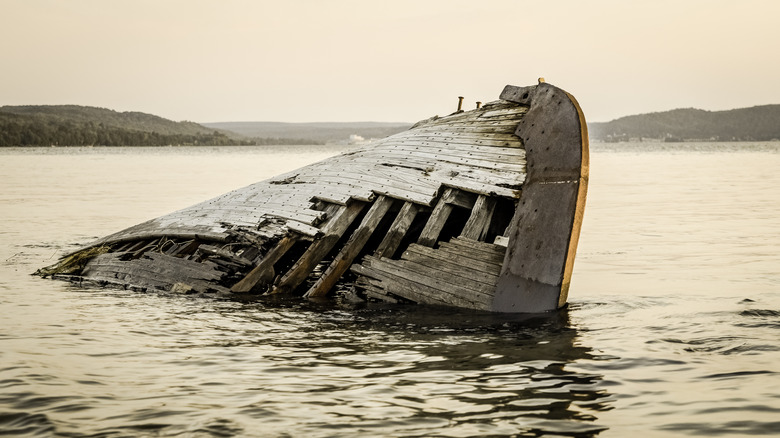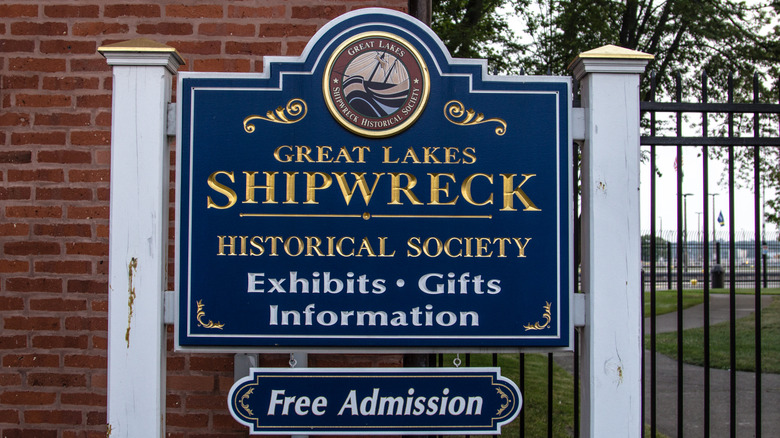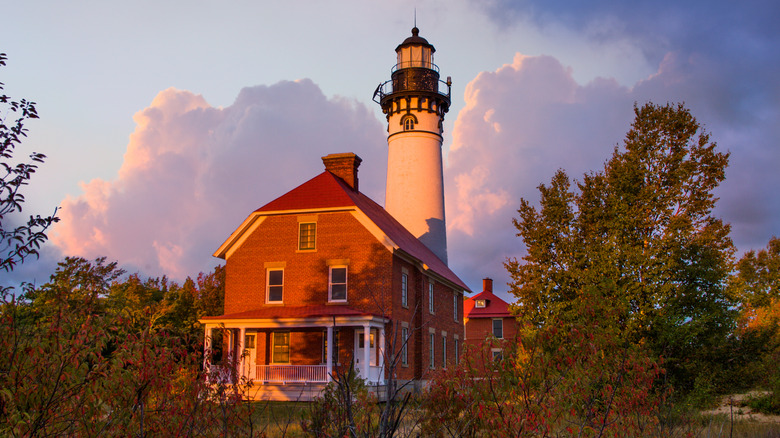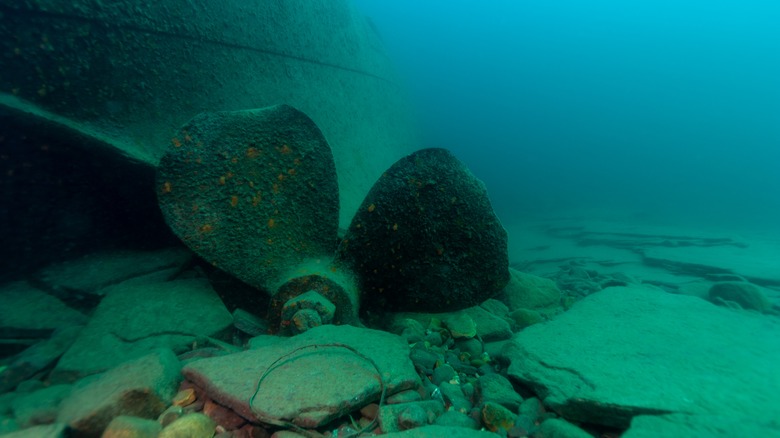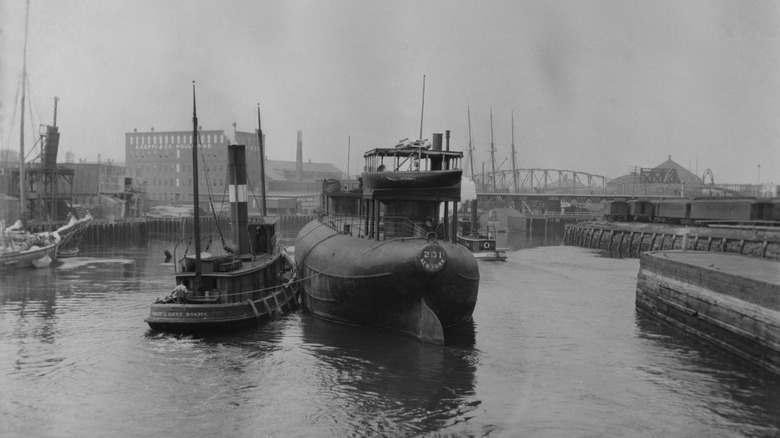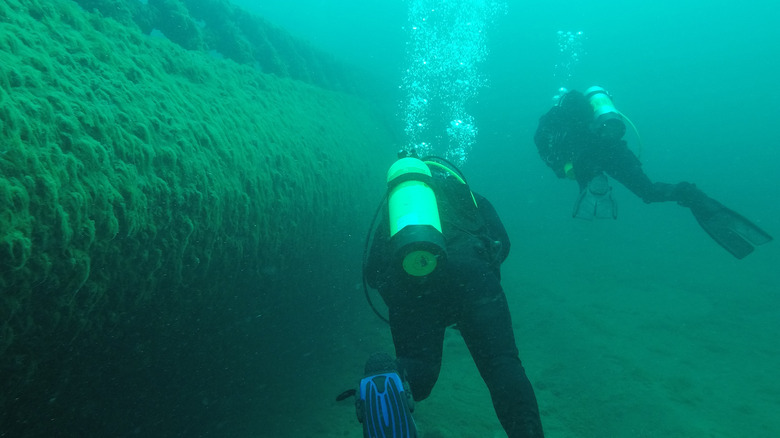An Astonishing Number Of Ships Have Sunk In The Great Lakes
Nature has a way of creating astonishing sights and ecosystems that have given life to human existence for centuries. A perfect example of these formidable wonders is the Great Lakes. The Great Lakes — made up of Ontario, Huron, Michigan, Erie, and Superior — are interconnected by smaller bodies of water, including rivers, straits, and smaller lakes. Combined, the Great Lakes span a total of 94,000 square miles. Making them the world's largest freshwater system, according to History.
Major cities in the United States and Canada line the shores of the lakes and rely heavily on them for industrial needs. The Great Lakes-St. Lawrence Seaway System opened in 1959, allowing cargo ships to pass through from the Atlantic Ocean to Duluth, Minnesota. The sheer size of the lakes is impressive enough, but the number of ships that sail on the waters for both commercial and recreational purposes is beyond comprehension for a body of water still considered to be a lake. Sadly, with so many visitors and sailors come inevitable tragedy, and the Great Lakes is the home of a surprising number of shipwrecks.
There are enough shipwrecks in the Great Lakes to justify an entire museum
The serene shores of the Great Lakes and the wonders they have to offer are beautiful masks for what lies beneath the water's surface. To the locals, there's no secret the Great Lakes is the home of a large number of shipwrecks. So many, in fact, that it warrants an entire shipwreck museum dedicated to the history of the sunken vessels and lost lives. According to the Shipwreck Museum, there are over 6,000 shipwrecks on the Great Lakes. However, this number seems small in comparison to the estimated 30,000 lives claimed in these catastrophes.
The Shipwreck Museum now serves as a way to educate the public on the history of the Great Lakes and the different sort of purposes it serves. Some historians even believe the number of shipwrecks is closer to around 25,000, according to Marine Insight. The amount of wreckage at the bottom of the lakes might be surprising, but while most tend to think of harsh ocean waters when thinking of shipwrecks, the Great Lakes can still be incredibly dangerous. The Great Lakes have tides, stormy weather, and low visibility that can make them treacherous for those sailing across their waters.
Hundreds of ships rest forever underwater near the Au Sable Point Lighthouse
Near the Au Sable Point Lighthouse on the southern part of Lake Superior is the famous Shipwreck Coast. The area lives up to its name as hundreds of ships that met their end now rest along the coast in a dreary historic gravesite. The sunken vessels are far from unnoticed. Nowadays, there are glass bottom boats that take visitors out for a closer look at the unique world just beneath the surface (via Shipwreck Tours).
A peek at the past, and a chance to learn of the lives lost and boats destined for demise attracts the attention of many, including historians, tourists, and locals alike, all fascinated by the preservation of what used to be. Much of the wreckage is extremely old, and while it seems there should be more deterioration than there appears to be on these sunken curiosities, there's a reason they remain so intact for thousands to explore.
The preservation of the wreckage is a priority for both humans and nature
The shipwrecks in the Great Lakes are now viewed as a sort of macabre historical treasure by tourists and academics. As a result, their preservation has become a high priority even to nature, it seems. The remarkably cold Lake Superior temperatures are a natural deterrent to micro bacteria that would otherwise flourish and break down what remains of the shipwrecks at the Shipwreck Coast, according to the Chicago Tribune. Another natural advantage Lake Superior has is its lack of salt. This means that the zebra mussels found in other lakes haven't touched any of the wreckage — helping to preserve the underwater graveyard.
While Mother Nature is doing her best to keep these ships untouched, humans have also taken extra precautions. According to the State of Michigan, there are 133 underwater preserves that protect 7,200 square miles between Lakes Superior, Michigan, and Huron. The preservation is done with the help of mooring buoys that line many of the shipwreck sites and protect them from further wreckage that may be caused by boat anchors. These buoys also help provide continued access to the sites.
Sunken vessels are still being discovered
There may seem to be an endless amount of shipwrecks in the Great Lakes, but there are still plenty being discovered. In 2022, a rare discovery of a 292-foot whaleback boat was made at the bottom of Lake Superior, according to CNN. The Great Lakes Shipwreck Historical Society found the vessel and eventually determined it to be Barge 129. The boat is one of only 44 whaleback boats ever built that sailed the Great Lakes in the 19th century.
Executive director of the Great Lakes Shipwreck Historical Society, Bruce Lynn, said of the find, "The fact that this was the last whaleback vessel to sink on the Great Lakes that hadn't been discovered, this is one we wanted to find for a very long time." The ship sank due to bad weather conditions on October 13, 1902, and was found in August 2022 with the use of a sonar system and a remotely operated vehicle equipped with high-intensity lights and cameras.
The wreckage is to be explored, not robbed
With so many shipwreck sites comes the excess wreckage and debris that come with it. Historical artifacts, in the form of cargo and boat fragments, line the sites. For years many of these artifacts have been picked up and found new homes with various divers and explorers. Nowadays, harvesting anything from these watery graves is illegal, thanks to the work of the Michigan Underwater Preserves.
Exploring and learning about these areas and the grave collision of humankind and the ecosystem of the Great Lakes is still very much encouraged. However, for divers, the old phrase "take only pictures, leave only bubbles" is a requirement. The awe these areas inspire, partnered with the beauty and wonder of the Great Lakes, is like nothing else in the world. Though how these popular tourist attractions came to be serves as an eerie reminder of just how quickly nature can go from beauty to beast, and no matter how big and powerful the ships are built, they can always sink under the right or rather wrong conditions.
